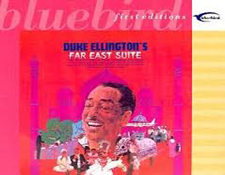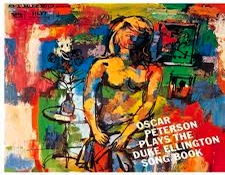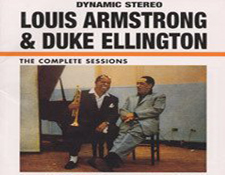It’s the time of year for saving money!
 It’s funny how things come together in the world of reviewing. Like this, I’ve had a couple disparate releases related to Duke Ellington sent to me over time, both sitting around for potential review but I never felt there would be enough to write about in the context of a useful piece for the readers of Audiophilereview (ie. “great album, sounds awesome, go buy it!”). Recently I discovered two additional Duke releases I felt were important and which I felt I could assemble into a useful, contextual round up of some music you may have missed:
It’s funny how things come together in the world of reviewing. Like this, I’ve had a couple disparate releases related to Duke Ellington sent to me over time, both sitting around for potential review but I never felt there would be enough to write about in the context of a useful piece for the readers of Audiophilereview (ie. “great album, sounds awesome, go buy it!”). Recently I discovered two additional Duke releases I felt were important and which I felt I could assemble into a useful, contextual round up of some music you may have missed:
Far East Suite — Last year Joe Jackson came out with a fine tribute to Duke which I reviewed enthusiastically. Having “gone deep” on Duke’s music beginning more than 10 years ago — “gone deep” meaning I try to collect all of an artist’s music and read whatever books/articles I can find to better understand their accomplishments — I was amazed that the Joe Jackson album introduced me to a piece of music from later in Duke’s career that I’d completely overlooked. The track “Isfahan” came from Duke’s 1967 Far East Suite release and is just a gorgeous piece of music, written by Billy Strayhorn. I started keeping my eyes out for a used copy of the album on LP first (my usual process, to keep costs down) and indeed one arose late last year, a Mono copy in nice condition for $1 at a garage sale. I was not disappointed and with each listen this album has impressed me with its modern flair – this doesn’t sound like music you’d expect from Duke Ellington. Late in his career, Duke was still growing and pushing his limits as a composer and performer and this is prime evidence of it. Indeed, the genesis of the album had to do with a diplomatic world tour that Duke and his band undertook in 1963 in conjunction with the U.S. State Department, a journey that took the band to India, the Middle East and other exotic locales. Not surprisingly, the tour spurred a bunch of new compositions and in 1967 the Far East Suite album resulted.
The track that really got me hooked on this album is called “Mount Harissa” which sounds like a lost Vince Guaraldi piece! Yet, here you have Duke swinging away on this sweet Bossa Nova-tinged tune which opens with the band stripped down to its core (drums, bass, piano) that is positively mesmerizing; when the band kicks in, well it all just swings like nobody’s business. This is really primo Duke!
Now while I like the mono LP just fine, I have to admit it has a bit of that compressed/box-y sound that graced some albums in the mid-1960s. Thus imagine my joy and surprise to come across a CD copy of the album this past weekend, part of the “Bluebird: First Editions” reissue series from 2003. While I don’t know how the CD was made, I do know that it sounds far more cinematic than the mono release. It’s being in stereo helps a great deal, but it also feels like there is more presence than I was hearing on the LP. Perhaps it was made from a uncompressed master tape? One would hope! This release comes with a slew of unissued alternate takes and such so its a pretty important reissue for the Ellington fan. I’ll go so far as to call this essential.
 Oscar Peterson Plays The Duke Ellington Songbook — When collecting artists as prolific as Duke Ellington and Oscar Peterson, its easy to overlook an album in their seemingly endless catalogs. It feels like at every turn I’m finding new recordings from these two artists which warrant my serious attention. So, finding an album of one of my favorite pianists, Oscar Peterson, playing the music of Duke Ellington, was a real treat! This collection came out in 1998 and claims to have been made from 96 kHz / 24-bit transfer, compiling two releases onto one long 72 minute CD (44.1 kHz, 16-bit). Basically it finds Peterson in his first trio setting from 1952 with Barney Kessel on guitar and Ray Brown on bass doing a selection of Ellington classics — mostly from the Blanton-Webster era of the band — recorded in Mono. Then in 1959, the classic version of “The Trio” (swapping out Kessel for Ed Thigpen on drums) recorded many of the same tunes in the new format du jour, Stereo. The performances are of course sublime as Peterson could pretty much play anything and make it his own. Curiously, the first album is made from a disc source — obviously the master tapes are missing — but they wisely didn’t use too much noise reduction, keeping much of the recording’s dynamic range. So, you’ll have to suck up a bit of hiss on this one, at least for the first half. By the time you get to the 1959 recordings, however, the fidelity is much better. The playing is also different — the band is more experienced and is playing in the more mature laid back manner for which Peterson was renown. He finds the heart and soul of the music, letting the melodies linger and shine in the spotlight and keeping his propensity for manic soloing to a minimum. This less-is-more approach is simply gorgeous, such as on “Sophisticated Lady.” Yet, Peterson still swings madly (as Duke himself might have said when hearing a track like “Cotton Tail”). This album clearly has THAT swing Duke was talking about oh so many years ago…
Oscar Peterson Plays The Duke Ellington Songbook — When collecting artists as prolific as Duke Ellington and Oscar Peterson, its easy to overlook an album in their seemingly endless catalogs. It feels like at every turn I’m finding new recordings from these two artists which warrant my serious attention. So, finding an album of one of my favorite pianists, Oscar Peterson, playing the music of Duke Ellington, was a real treat! This collection came out in 1998 and claims to have been made from 96 kHz / 24-bit transfer, compiling two releases onto one long 72 minute CD (44.1 kHz, 16-bit). Basically it finds Peterson in his first trio setting from 1952 with Barney Kessel on guitar and Ray Brown on bass doing a selection of Ellington classics — mostly from the Blanton-Webster era of the band — recorded in Mono. Then in 1959, the classic version of “The Trio” (swapping out Kessel for Ed Thigpen on drums) recorded many of the same tunes in the new format du jour, Stereo. The performances are of course sublime as Peterson could pretty much play anything and make it his own. Curiously, the first album is made from a disc source — obviously the master tapes are missing — but they wisely didn’t use too much noise reduction, keeping much of the recording’s dynamic range. So, you’ll have to suck up a bit of hiss on this one, at least for the first half. By the time you get to the 1959 recordings, however, the fidelity is much better. The playing is also different — the band is more experienced and is playing in the more mature laid back manner for which Peterson was renown. He finds the heart and soul of the music, letting the melodies linger and shine in the spotlight and keeping his propensity for manic soloing to a minimum. This less-is-more approach is simply gorgeous, such as on “Sophisticated Lady.” Yet, Peterson still swings madly (as Duke himself might have said when hearing a track like “Cotton Tail”). This album clearly has THAT swing Duke was talking about oh so many years ago…
]]> The Complete Sessions: Louis Armstrong & Duke Ellington — Wow, what do you say about a recording that pulls together two of the architects of jazz some forty years after their 1920s debut and ascension. You’ve probably heard about this album before — and if you haven’t you can imagine that it’s probably pretty great — so I’m going to just babble on about how good it sounds — it does! I’m also going to babble on about something I discovered tonight while writing this review: it plays on my new iMac! Now, I have an Oppo universal player in my home theater set up which is what I’d normally would have been listening to this disc on as it plays DVD Audio discs; it sounds great there. What I didn’t consider with these Classic Records HDAD discs (an early form of DVD Audio disc; this one is dated 1999) was that they might have a PCM layer on it and thus could play on a wider range of players in the same fidelity. Indeed, this disc plays just dandy on my iMac both using the built in DVD player and the VLC player I have; the latter gave me visual confirmation that I was indeed hearing the music in 96 kHz, 24-bit fidelity. It sounds pretty tremendous and full bodied, with crisp highs and lows plus a pleasing — if somewhat early 60s styled, very discrete left-right — stereo sound stage. With the audio running from my iMac through to the AudioengineD1 DAC before hitting my old Denon AVR 3802, its wonderful to hear this grand playing by the Duke and company in this sort of pristine fidelity. Now I know I can enjoy this music all over my house, not just in the living room. Score! Just to hear this version of “Black & Tan Fantasy” makes this album an essential to own in any format.
The Complete Sessions: Louis Armstrong & Duke Ellington — Wow, what do you say about a recording that pulls together two of the architects of jazz some forty years after their 1920s debut and ascension. You’ve probably heard about this album before — and if you haven’t you can imagine that it’s probably pretty great — so I’m going to just babble on about how good it sounds — it does! I’m also going to babble on about something I discovered tonight while writing this review: it plays on my new iMac! Now, I have an Oppo universal player in my home theater set up which is what I’d normally would have been listening to this disc on as it plays DVD Audio discs; it sounds great there. What I didn’t consider with these Classic Records HDAD discs (an early form of DVD Audio disc; this one is dated 1999) was that they might have a PCM layer on it and thus could play on a wider range of players in the same fidelity. Indeed, this disc plays just dandy on my iMac both using the built in DVD player and the VLC player I have; the latter gave me visual confirmation that I was indeed hearing the music in 96 kHz, 24-bit fidelity. It sounds pretty tremendous and full bodied, with crisp highs and lows plus a pleasing — if somewhat early 60s styled, very discrete left-right — stereo sound stage. With the audio running from my iMac through to the AudioengineD1 DAC before hitting my old Denon AVR 3802, its wonderful to hear this grand playing by the Duke and company in this sort of pristine fidelity. Now I know I can enjoy this music all over my house, not just in the living room. Score! Just to hear this version of “Black & Tan Fantasy” makes this album an essential to own in any format.
I have one last but important caveat in touting this disc: I just checked on Amazon for a link to this now out of print album and someone is selling it there for crazy money — charging more than $7,000! Please, Please, Please, Dear Readers, wherever you are, do NOT spend that kind of money on this disc. You can find an original album or a reissue for well under $50 elsewhere that will sound just fine. Yes, this sounds great but not $7,000 great! Be smart about your purchases… don’t let yourself get ripped off by unscrupulous sellers!
Now, you may be asking where is the last release I alluded to at the start of the review? Well, you know what? In comparison to these releases above it simply doesn’t rank so I’m not even going to talk about it…
It ain’t got that swing, so it don’t mean a thing…
Mark Smotroff is a freelance writer and avid music collector who has worked for many years in marketing communications for the consumer electronics, pro audio and video games industries, serving clients including DTS, Sega, Sony, Sharp, AT&T and many others. www.smotroff.com Mark has written for EQ Magazine, Mix Magazine, Goldmine/DISCoveries Magazine, BigPictureBigSound.com, Sound+Vision Magazine and HomeTechTell.com. He is also a musician / composer whose songs have been used in TV shows such as Smallville and Men In Trees as well as films and documentaries. www.ingdom.com Mark is currently rolling out a new musical he’s written: www.dialthemusical.com.






